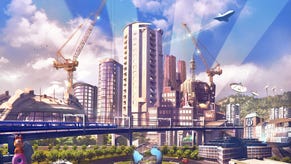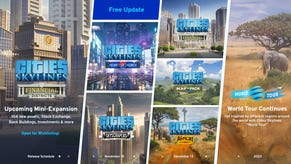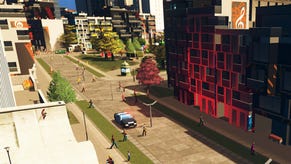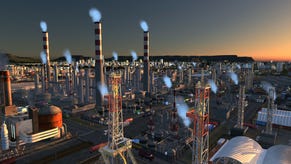Building A Self-Sufficient City In Cities: Skylines – Part Two
Arcologyology
Welcome to the second instalment of my attempt to recreate an arcology in Cities: Skylines. As those of you who read the first part will know, I'm not talking about the bubble-topped utopia palaces of SimCity 2000 - I'm talking about a real arcology in the real world. Like Masdar City.
Masdar City is a sustainable, self-contained settlement under construction in the desert south-west of Abu Dhabi in the United Arab Emirates. It was originally supposed to have been completed by 2014, but the global financial crisis has meant that right now it just consists of a handful of office blocks. I've recreated the detailed plans for the city in Cities: Skylines, and I'm about to see if anyone actually wants to live in the paradise that I've created.
I'm genuinely nervous as I hit unpause. I've spent several hours getting things looking nice - drawing a sparse network of roads and a thick network of public transport systems, zoning out dense residential and commercial zones, and supplying all the myriad services that a self-sufficient city might need, from health and education to power and sewage. This is possibly the first time that anyone has seen whether Masdar City is actually going to work.
To start with it doesn't. At all. Days pass and my green residential-zoned areas stay green. I re-zone a few of them on the outskirts of the city's twin squares as low-density, and suddenly construction begins. The first house to pop up is called The Foggy Residence, and no-one is living in it. I notice I'm losing 50 grand a week, and my grip on my mouse tightens a little. I hope my benefactors are willing to be a little patient.
More houses pop up, and people begin to move in. Seventy-nine brave souls in the first month. An immediate problem is power - without stringing unsightly power lines across the city, how can I connect up the small islands of habitation? My incineration plants aren't processing nearly enough trash yet, so my answer is to plop down a few more solar power plants closest to the edges that are growing - I can always demolish them later. There's no power at my airport or water treatment facilities either, so I equip each with a wind turbine.
The second month, my population rises to 135 and I spot my first citizen stuck in a traffic jam behind three empty buses. He's called Oscar Graham, and works at the crematorium. Probably a fairly easy job, given that hardly anyone lives here yet and so no-one is dying. He parks his car next to his unpowered house in the south of Big Masdar (as I've named the larger square), and gets out with wife and kids in tow. His wife is named Sabrina, and also works at the crematorium. I suppose it's not like there was any work to do to distract them from their blossoming romance. The kids are named Rosemary and Piper, which sound to me like exactly the kind of names that people who would be the first to move into an unpowered sustainable city experiment would give their children.
Behind the Grahams' car is a colleague of theirs called Winston Cooper. He rams his vehicle into the back of their parked car, driving through it and then through their back garden in what appears to be a great rage. Perhaps Winston is jealous of Oscar's happy home life, as he parks in the bus station car park next door and gets out with his wife Audrey. Audrey works at the police headquarters. Perhaps she's the police chief of the city? That would be unlikely in the real United Arab Emirates, where just 21 percent of women are part of the workforce, and every one has a "male guardian" who must give their permission if the woman wants to remarry - a requirement derived from Sharia law. Women are regularly victims of flogging and stoning - punishments doled out by Sharia courts for offences such as premarital sex and adultery. The country ranks 109th out of 136 in the Global Gender Gap Index.
But there are signs of change. Education for women is widely regarded as the best way to close that gender gap, and the United Arab Emirates boasts one of the highest rates of women in higher education - 95 percent continue their studies after high school, and 70 percent of the country's college graduates are female. Abu Dhabi also has a 14,000-strong 'Businesswoman's Association', which counts among its number Sheika Lubna bint Khalid bin Sultan al Qasimi, the country's minister of Foreign Trade and one of Forbes' magazine's 100 most powerful women in the world.
I'm worried the Grahams and Coopers might move out if I don't power their houses soon, so I plonk down another solar plant nearby. I realise that I've accidentally zoned over my green lanes while spreading low-density residential, so I'm forced to evict a few people and fill their empty lots full of trees again. I take a look at my city policies, and enact smoke detector and high-tech housing initiatives. This seems accurate for the spirit of the project - Masdar's homes have no light switches or water taps. Both are instead controlled by movement sensors, which cut electricity and water consumption by 51 and 55 percent respectively. Traditional architectural principles have been combined with modern materials to minimise energy requirements for both lighting and cooling too.
I make a cup of tea and watch as the city grows further. The population is rising steadily, but my fondness for dropping additionalsolar power plants all over the place is hurting the budget. There are more problems too - the farming district in the southern half of the city is completely unoccupied, and many of the commercial buildings that sprang up fast after the city was opened are being abandoned due to lack of workers. I lower taxes a little in the farming district to fix the first problem, but there's not a lot I can do about the second until the population rises.
That chicken-and-egg issue is going to be a problem for the real Masdar City - right now its population is a handful of students, and the only businesses supported are a few cafes, an organic supermarket, a bank and a travel agency. The hotbed of renewable technology startups promised by its founders in 2006 have yet to materialise, stymied by the regulatory hurdles faced by foreign investors who want to set up shop in the United Arab Emirates, like a requirement that any company be majority-owned by locals. Those regulations have recently been lifted within the city walls, but it's still empty of both major multinationals and smaller start-up firms.
A few in-game years pass, and my virtual Masdar is beginning to boom. The squares glitter with high-rises, and the farming district has filled out impressively. But with the farms comes a problem that I was hoping I wouldn't have to deal with in a sustainable city of the future. Traffic. The ground around virtual Masdar isn't too fertile, so my farming industries are forced to truck in & out the supplies they need. It's that or convert the entire district to offices, which I feel would be rather against the spirit of the original plans. So instead I spend my time upgrading the highway connection and fiddling with the roundabouts on my ring road to boost their capacity. The real Masdar has thought carefully about traffic. Private cars are confined to car parks around the city's perimeter, with only public transport allowed inside the city. Unfortunately that's not an option for me in Cities: Skylines, so I'll need to cope as best as I can with the game's systems. I upgrade my ring road to a higher capacity, and start to wonder if it's worth building a cargo port.
Then I glance down to the bottom of the screen. It's 2020, which is when the real Masdar City is expected to be completed. What's more, I'm finally profitable - the 21,500 residents (about half as many as in the plans for the real Masdar) are bringing in enough tax income to make my city financially viable. That would probably make Al Qasimi, the country's minister of foreign trade, happy - but I'm not going to call this project a success until I've seen my citizen happiness ratings. Turns out that they're good. Residential happiness is at 90 percent, industrial at 93 percent, and commercial is at 72 - no doubt miffed about the traffic. As I'm looking at the stats, one of my residents chirps: "What a great city! I would think I'm dreaming if I didn't know otherwise."
I've clearly succeeded in building a happy and profitable city, then. But is it sustainable and self-contained enough for me to be able to call this a true arcology? I'm not convinced it is. The traffic problems are the result of a huge dependence on outside products to feed the city's industry and commerce. Without turning the picturesque farmland of the plans into an office district, that's not a problem I'll be able to fix. It might be possible to build a real arcology in Cities: Skylines - and it definitely will be once modders get cracking on developing some sustainable low-density businesses and allow buildings to be built on footpaths. But the Masdar City I've created in Cities: Skylines is not an arcology. I can't help but wonder if the one being built in the desert of the United Arab Emirates will ever become one either.
























